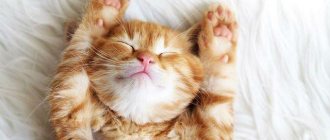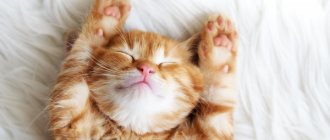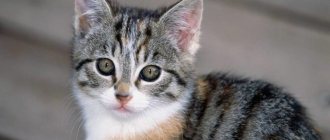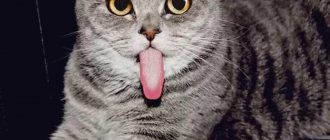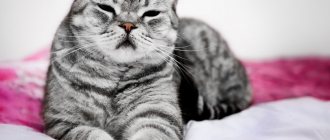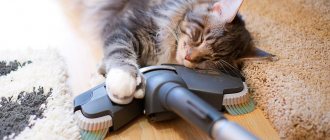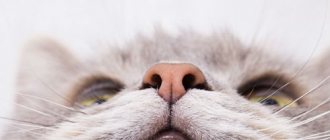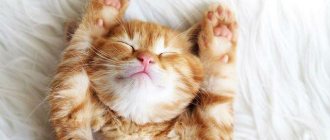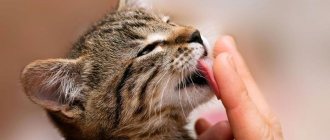Home Animals Cats
A purr is a rhythmic vibrating sound made by cats over a long period of time. Typically, most cats have the ability to purr. But other animals, such as hyena, badger, mongoose, can make similar sounds.
In his book “The Cat No Fool,” the famous English writer Terry Pratchett wrote: “Rumbling is not a trifle. All is forgiven for a cat’s purr!” Indeed, for such a sweet and gentle purring, furry pets want to forgive everything: both their bold antics and hands scratched by sharp claws. Indeed, we love cats for their wonderful ability to purr and thus calm us down.
Every cat owner knows that if a cat goes to bed next to him and begins to purr, the person begins to relax and want to sleep. Therefore, people concluded that a purring pet calms itself, and this is good. But why he does this and for what purpose - no one has yet figured it out.
To this day, scientists do not know the exact answer why some cats purr and others do not. This could be due to anything, for example, a change of place of residence or dissatisfaction with the quality of life. Cats may not like their owner or the food they are fed. So, some owners may not hear their pets purring at all and only hear it under extreme circumstances. Typically, cats purr when they are happy and full or feel completely safe. Less often, a cat may purr from the pleasure of eating, but it happens that a cat may like food so much that it begins to purr while eating food.
But how is the process of rumbling itself formed? How does a cat get the ability to purr? From this we will begin to understand why cats purr.
Specifics of cats purring
For a long time, scientists could not figure out why cats purr, because they do not have a special organ responsible for this. And only recently it was possible to more or less understand why this still happens. In the process of purring, special parts of the brain are involved, which send impulses to the muscles and because of which the cats’ vocal cords begin to vibrate. The vibration is transmitted to the hyoid bones, which are located between the base of the skull and the root of the cat's tongue.
After the vibration is transmitted to the bones, it spreads throughout the body, causing this characteristic sound to be heard. Unlike meowing, cats can purr both while inhaling and exhaling, because the sound of meowing passes through the vocal cords as air passes through and is produced only when exhaling. Therefore, cats can purr both when they eat and when they fall asleep. And small kittens along with eating mother's milk.
But why then can't tigers or lions purr? Only small felines, wild and domestic cats are endowed with this function. The secret lies in the specifics of the production of purring in cats. Small species are endowed with thin hyoid bones that can vibrate. And large predators have bones covered with cartilage and vibration cannot be transmitted through them, but they can roar excellently, impressively and loudly.
According to some experts, purring has several types. These types differ in the range of sounds from 50 to 150 Hertz. One type of rumbling can be when a cat lets its owner know that it is hungry or to pay attention to it. This rumbling is usually loud and short-lived. But if the cat is already fed and caressed, then its purring will be quiet and long, and the volume will not exceed 60-70 Hertz.
Cat purring mechanism
The sound of rumbling comes from the cat's larynx
Since humans cannot make purring sounds, like all other animals, the question arises, what do cats purr with? Do they have any special rumbling device for this? It turns out that not everything is so complicated.
The pleasant, soothing, soft sounds of purring occur as a result of the contraction of the throat muscles and the vibration of air inside the larynx, which leads to vibration. The amplitude, tone, and duration of purring may vary in cats, but the vibration frequency is within 20-30 Hz. The rumbling does not stop with inhalation and exhalation, but on the contrary occurs just during breathing.
When a cat purrs, a certain hormone is produced that has a calming function.
Research has also shown that the vibration from the purr strengthens the animal's bones, joints and skeleton due to the vibrations of the air. This is explained by the fact that such a habit could have been developed in the animal due to a sedentary lifestyle and to prevent muscle atrophy.
Interesting: kittens begin to purr when they are a couple of days old.
The main reasons why cats purr
There are many versions of why cats can purr and why, and here are the main ones:
- Thanksgiving. Purring, cats thank for food, warmth, stroking, affection. In these cases, a quiet purr is a clear sign of a satisfied cat.
- Relaxation. When cats feel calm, they purr. So, kittens, when they suck a cat’s milk, purr from calmness and tranquility. You can’t meow and eat at the same time, so they purr quietly.
- Expression of emotions. Some believe that a cat's purring is a kind of human singing. With the help of various intonations, sounds and vibrations, cats show their emotional state at the moment. Likewise, people, when they are puzzled by something or, on the contrary, relaxed, hum some song under their breath.
- Communication between kittens and mother. By purring, the kittens tell their mother that everything is fine with them, they are full and happy. This is especially important for wild cat breeds, since adults often leave babies alone when going hunting.
- Meeting other cats. When a cat meets another, it begins to purr, showing its greeting and friendliness. Strong males, when meeting weak ones, make it clear by purring that they will not attack them.
- Self-medication. During illness or stress, cats begin to purr to calm down and bring their body back to normal. The vibrations they produce improve blood circulation and improve metabolism. With the help of rumbling, a cat can warm up or calm down from fear. Then it is better not to disturb him and let him calm down on his own.
- Getting ready for bed. When cats are about to fall asleep, they may begin to purr softly. Measured vibration helps them calm down and relax before bed. Scientists have found that during purring it is impossible to listen to the lungs or heart, because the vibrations spread too strongly. This helps pets get a better night's sleep.
- Presence of hunting instinct. Cats can purr while watching a bird in the window or the rustling of a leaf on the lawn. This is how they show their interest in a moving object.
- Self-defense. Cats can purr loudly and belligerently when they sense danger for themselves or their offspring. In such cases, it is better not to touch them, because they can attack and scratch painfully.
- Fear. Feelings of strong fear can be caused by an exciting purr, which means that the cat asks not to touch it, because it is defenseless.
- The desire to receive something. When cats want a piece of tasty food or affection from their owner, they begin to purr. This often works on people and furries often get what they want.
- Presence of illness. By purring, cats can communicate about possible illnesses, and the purring is restless and loud. Just in case, it is better not to postpone a visit to the veterinarian.
Thus, cats can purr because of anything. But why they do this can only be understood by the most observant cat owners who carefully monitor the health and well-being of their pets.
Purring, the cat calms down
In a stressful situation, Murka stabilizes its emotional state by purring. Thanks to the amplitudes of a certain frequency, the animal’s blood pressure normalizes, the heart rhythm improves, and the nervous system calms down. The pet seems to be fenced off from the external bustle and focuses on its sensations. Often in an unfamiliar situation, an excited cat begins to purr.
The rumbling serves as a kind of sedative before bed. When tuning in to rest, the cat “vibrates”, trying to calm down and distance itself from external hustle and bustle: noise, light and movement.
Why do cats purr when petted?
In fact, human touches are irritating for a cat, but she may not always react with displeasure. It is clear that if you stroke your pet against the grain or when he is not in a good mood, then in this case the cat may twist its tail in displeasure or even scratch it. However, if you gently pet your pet when she wants it, she will most likely begin to purr with pleasure. Cats are very sensitive to the mood of the owner and see when he strokes lovingly, so they purr in response, expressing mutual love and trust.
Purring as a means of communication for cats
Purring sounds help cats communicate with each other, warn about something or report. If a cat purrs quietly, this may mean that she has a friendly attitude, she is calm and friendly. A loud purr indicates the dominance of this cat over its relatives. This is how she shows a weaker opponent that there is no point in fighting with her and the weaker cat does not have to worry about a possible attack. Purring can also mean that the cat is completely defenseless and asks you not to attack it.
It is interesting to watch the relationship between mother cat and kittens. Cubs can purr if they are hungry or, on the contrary, if they are full and do not need feeding. They also purr when they are satiated with their mother's milk with pleasure. The mother cat herself purrs, letting the kittens know that they are safe and under her protection. For example, when she purrs as she approaches the kittens, she makes it clear that mom is already close and they don’t have to worry about anything.
The amazing thing is that cats can heal each other by purring. So, if one cat feels bad, the second one can come up, lie down next to him and purr, encouraging him and calming him down.
Video
A purring cat can calm you down better than valerian; all happy owners who have managed to earn the cat’s affection know this. What do these strange sounds mean and how does a cat make them? Let’s try to figure it out.
If a cat purrs and rolls on the floor, what does this mean?
Scientists have tried to study the phenomenon of purring. They found that cats communicate with each other and with their owner using purring sounds. It is assumed that purring can heal the body of the animal that emits it from diseases.
A purring cat that rolls on the floor expresses pleasure from life or gratitude to the owner for a delicious dinner. The purring of a cat also has a calming and healing effect on humans.
When a cat purrs and then bites sharply for no reason why this happens
Cats often purr to express their defenselessness. When they are in pain, purring sounds help them produce special hormones necessary for healing. If a purring cat bites harshly, leave him alone. Something hurts him, and you interfered with the self-healing session.
The cat purrs day and night at the cat what to do
Cats will often purr when they are around an animal or person who is feeling unwell or when they want to express affection. Perhaps the cat, purring next to the cat, thus achieves mutual sympathy. If your cat's purring really bothers you, try putting a calming collar with ferromones on the cat or moving the cat to another room.
Why does a cat purr during labor?
Childbirth is stressful for a cat; no one injects her with painkillers. Purring helps to soothe pain and ensure a successful birth. It’s good that the cat doesn’t yell, but purrs – it relieves the owner’s stress and helps himself. A cat often purrs when communicating with kittens when she wants to calm them down, help them, or feed them.
A cat constantly purrs loudly when petted, what does this mean?
Loud purring is a consequence of the interaction of electrical impulses in the cat’s head (in response to stroking) and the muscular apparatus of its vocal cords. The loud sound of purring means that the animal is happy with life and wants its owner to hear it.
Why and why cats purr like a tractor purr biological fact
Rumbling and purring are the same sound, but different in strength. The purring or rumbling apparatus is located in cats between the base of the tongue and the base of the skull - these are special hyoid bones. Muscle contractions of the vocal cords cause them to vibrate, and the cat begins to purr like a tractor.
Rumbling is caused by certain cat emotions: pleasure, anxiety, tenderness, fear, pain. The exact emotion an animal is experiencing can be judged from the context of the events taking place.
In this matter, many people have ambiguities, which can be sorted out in the material of this article, written in the format of questions and answers. If os...
This article contains information that allows you to become better acquainted with typical situations that you have to deal with in practice. Yes...
A rather interesting question is asked by adults and children, namely: “Why do cats purr?” This is a really interesting topic to think about. After all, everyone thinks that the purring of cats depends on pleasure. That is, when a cat feels good, it makes soothing sounds. Indeed, the sounds a cat makes are very helpful in relaxing and even falling asleep. Some people say that their cat tells them bedtime stories. So, let's find out why cats purr?
Why do cats purr from a physiological point of view?
Why cats purr can also be explained by physiological processes in their bodies. Perhaps why cats purr is influenced by electrical impulses emanating from the brain. This explains why, when cats are hurt or scared, they begin to purr. When vibration affects the brain, special substances are produced that dull pain and calm the animal.
There is another explanation about the purring of cats. Given the inactive lifestyle of cats, their muscle mass weakens during sleep, and vibration, that is, rumbling, causes the opposite effect. Under its action, muscle mass increases, osteoblasts in the bones are activated, as a result of which bone tissue is produced. Because cats sleep for a long time (about 18 hours a day), purring serves as training for them.
Thank your pets for purring!
We should be grateful to purring cats for their amazing sensitivity, ability to relieve stress, calm anxiety, reduce headaches and stabilize blood pressure.
You and I don’t purr, but we can show our love and care in other ways, say “thank you” for being there, pet them or treat them to something tasty. Our attention to them will be the best gratitude!
Probably every person knows what a cat purrs sounds like. But not everyone knows why this happens and what causes a cat to purr. In this article we will tell our readers why cats purr, what this behavior means and what situations it is typical for.
[Hide]
Is it true that a cat's purring cures diseases?
According to a rather interesting theory about the benefits of purring for cats themselves, during purring, animals produce a special hormone that acts as a sedative and pain reliever. It has been noticed more than once that during periods of weakness, cats purring became calmer and more cheerful.
Scientists from the University of California, having studied the effect of cats' purring on their bodies, suggested that the vibration that occurs during purring strengthens the animal's tendons and bones, accelerates wound healing and relieves pain, and also improves blood circulation. Thus, vibration eliminates the negative consequences of cats’ passive lifestyle, because they remain in an active state much less than in a passive state - only 6-8 hours.
The purring of a cat has a good effect not only on the cat itself, but also on its owner. It has been proven that by purring next to a person, cats help relieve stress, relieve headaches, normalize blood pressure and simply calm them down.
This theory about the benefits of purring is used as a method of treating people with diseases of the musculoskeletal system and nervous disorders. Thus, British scientists have proven the benefits of purring for humans. Experts are confident that cats can heal people simply by being near them and purring, healing both themselves and the person.
Interesting facts about rumbling
Cheetahs can purr too
- Not only domestic cats have the purring function, but also such predators as the cheetah, snow leopard, raccoon, puma and jaguar.
- But the tiger and lion can growl more than purr.
- Large ones from the cat family purr when exhaling, which is more like a roar, and small ones both when inhaling and exhaling.
- A cat can purr only with one inhabitant of the house, whom it recognizes as the owner, and react to others with complete silence.
- To stop your cat from purring at the veterinarian's appointment to measure her heartbeat, you need to drown out her purring with the sound of water, and she will become silent.
- Cats purr from birth until death. Before her death, these may be the last sounds she makes. This is how she tries to calm down and ease her anxiety.
- Since kittens are born deaf and blind, the mother cat's purrs help them locate her and feel safe.
- There are services for listening to cat purrs online.
- Purring helps cats recover from injuries, promotes bone healing and strengthens joints.
- Purring before bed helps cats fall asleep.
- During long sleep, rumbling replaces physical exercise for the cat.
- In 2015, the cat Merlin was included in the Guinness Book of Records for the loudest purr of about 68 decibels (average frequency 25 decibels), that is, the noise level between a sewing machine and a hair dryer.
That loud cat Merlin and his owner
Yet, in most cases, with its purring, a cat next to its owner expresses its love, recognition, calmness and trust. A cat, with its purring, will not only thank its owner for his care and kindness, but will also help him cope with fatigue, stress and increase his immunity.
If the cat is happy, the owner is happy too.
Why do cats purr when they're around people?
Why do cats often purr when people are sitting next to them? In general, this is a good signal for pet owners. This way it becomes clear that the cat feels good, cozy, safe with these people, she is happy with her life and the care she receives. Owners who are well acquainted with the nature of cats know that a loud purr means gratitude, and a quiet one simply means the pet is in a good mood or, perhaps, some kind of request.
When cats heal themselves, they purr and heal others around them. It’s not for nothing that they say that cats can cure a person from many diseases, including psychological ones. Thus, cats can cure depression or neurosis, reduce blood pressure and even relieve an attack of angina. Also, the purring of cats helps people with spinal diseases: they relieve pain from paralysis, arthritis, muscle atrophy, and even help astronauts rehabilitate after a flight.
Rarely do cat owners think about why their cute furry cats purr. They are just ready to give them a piece of delicious food for a session of calming purring, which helps get rid of anxiety, stress and just lift their spirits. Maybe that's why cats purr, to please their owners.
What if the cat doesn't purr?
All representatives of small cats almost always purr, but it happens that a pet may not purr at all. This is not a very good signal to think about. Carefully examine the animal; it may be in pain or weakened.
Maybe the cat is simply not in the mood. Take the animal in your arms, pet it, tell it something affectionately, or treat it to something tasty. If nothing has changed, you will have to take your pet to the vet. If a cat does not purr for a long time, this may indicate problems with the vocal cords or even brain activity.
It was said above that when there is rumbling, the doctor is not able to listen to the heartbeat or lungs. Veterinarians use an unusual technique in such cases. They turn on the water tap to minimum pressure. The sound of a flowing stream of water may remind the cat of a purr and he stops purring.
Anatomy of a purr
There is an opinion that purring is born deep inside the cat. In fact, the urcal is located much higher, in the area of the vocal cords. It is not known for certain whether the process of purring occurs consciously. Experts say that vibration originates from the central nervous system of the mouse.
It is there that a nerve impulse arises, causing vibration of the vocal cords. The air pushed out by the diaphragm affects the vibrating ligaments, and the output is everyone's favorite purr.
Experts have long been looking for an explanation for this mechanism. Research in the United States has shown that air passing through a cat's larynx affects two folds called false vocal cords. Moreover, this happens both during inhalation and exhalation. This fact proves the uniqueness of the purring form of communication, since a person, for example, can produce sound only when exhaling.
Do cats purr among themselves?
Cats use purring not only to communicate with humans. In addition to the dialogue between mother and kitten, you can hear two adult cats quietly “talking” about their own, cat-related things.
One of the signs of a good-natured greeting between cats is purring. A high tail, combined with guttural vibrations, is a sure sign of a welcome guest. The cat is happy to see its relative and is ready to make contact with him.
Cats living in the same territory resort to purring when washing themselves. By caring for each other's fur, the cats calm down and also take care of their friend. Another reason for rumbling is the call to play. Wanting to cheer up his neighbor, the cat begins to influence him with his weapon - loud purring.
Purring for a person
It is known that cats learned to meow in order to communicate with humans. Purring is a more universal language. With its help, murkas turn to both people and relatives.
There is no single reason for a cat to purr. Fluffy pets put a huge range of feelings into vibrating sound. It can be joy, fear, or peace.
It has been noticed that some pets use purring to try to cheer up their owner, who is in a sad mood. The cat persistently seeks the activity of a depressed person, trying in every possible way to attract attention. At the same time, her purger inevitably works at full capacity.
Some Murkies resort to cunning, trying to beg for a treat with the help of the treasured Murrr. Playing on the feelings of a loving owner, the cats purr in the name of cutlets and sweets. A person lulled by cat emotions becomes generous and kind.
Furry therapy, or the benefits of a cat's purring
Scientists say that a cat's purring has healing properties. It's all about the frequency at which the vocal cords vibrate. Sound in the range from 20 to 50 Hz (namely, the frequency of purring) has a beneficial effect on bone growth.
The human body detects vibrations of this frequency using nerve endings on the surface of the skin. The impulses entering the brain calm the nervous system and give peace. Thus, it has been proven that cats can indeed relieve stress.
Moreover, research is currently underway to use cat purring in the fight against osteoporosis. It's all about the negative energy that cats are able to direct towards themselves.
Owners often notice that cats try to lie down on the owner's sore spot. And for good reason. It has been proven that cats accurately determine the area of discomfort. Moreover, females have a greater “healing” effect, not males.
Interesting facts about cats purring
- The cat's purring is uncontrollable. If a cat decides to lull a person to sleep with sweet vibrations, only one sound can stop it - the sound of running water.
- While the cat is purring, it is impossible to listen to its heartbeat.
- Even kittens, deprived of the ability to hear from birth, are endowed with the talent to purr.
- There is a theory that cats developed the ability to purr specifically for communication with humans.
- A certain cat, Smokey, set a world record for being the loudest purring cat. The frequency of sounds produced by a cat's purr reached 70 decibels. For example, a vacuum cleaner operates at a frequency of 75 decibels. Why the cat purrs so loudly is unknown. The owners claim that this feature of the pet does not bring any particular inconvenience.
Purring is one of the secrets that murki possess, and which are still incomprehensible to humans. It is not yet known for certain how cats manage to purr, but it is known exactly why - to touch and warm a person.
Interesting facts about cats purring and more
- When in the same room, two cats will never purr. As experts say, cats use purring only for people, and they only meow among themselves.
- According to veterinarians, a cat is the only animal in the world that can purr. However, it has been proven that this is not the case, since most small cats, for example ocelots or lynxes, can purr, but in the case of large ones - lions or tigers, they can growl, and very loudly. For example, lions can roar up to 114 decibels.
- Only cats can hold their tail upright when walking. Their wild relatives carry their tail either horizontally or between their hind legs.
- Cats can learn some simple words, but it will take them a long time to learn this. So, there was one cat who learned the word “me” and when he wanted to eat he said it like: me-e-e-e. There are also cases when they learned the words “mom” and the like.
- By purring, cats can communicate not only with people, but also with animals of other species: dogs, horses, cows.
- About 95% of people talk to their cats and they usually respond to human cues with “meow”, but will sometimes say “meow”, perhaps to keep the conversation going.
- It has been estimated that cats can know up to a hundred different sounds, while dogs can only know no more than a dozen. Of the letters, cats can pronounce only seven: F, G, R, M, N, X, and V.
- When communicating with you, cats can not only purr or meow, their mood can be displayed in the movement of their tail, gaze or posture in which the pet lies. If you follow the tail, it will become clear that if the tip of the tail trembles, the cat is very attached to you and loves you. But if she waves at them energetically, it means she is outraged by something. If she is relaxed, she may occasionally wag her tail. Sometimes an animal may wag its tail because it has a choice. For example, the weather is rainy outside and the pet does not know whether to go outside or stay at home, and at the same time its tail may involuntarily move.
Musical purring of an adult cat
But still, why do cats purr, and most importantly, why is it necessary? There are a lot of assumptions, but one thing is certain. This is how they communicate and transmit information to each other. The reasons for the rumbling of a simple pet can be different. Sometimes they really try to express their pleasure and gratitude to the owner. Sometimes it happens that these sounds symbolize fear and frightenedness of the animal. And it happens that this is how they announce their imminent death. Therefore, it is quite difficult to accurately answer the question of why cats purr. After all, they, like people, are unique and individual, so the reasons for purring can be completely different. Note that if a cat is injured or dying, it will also begin to purr. This is due to the fact that during such a period she is completely defenseless.
